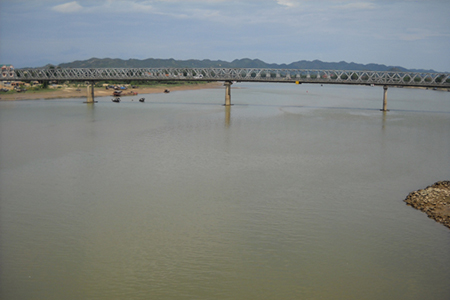Resembling the letter "S" on the map, Vietnam lies on the Eastern side of the Indochinese Peninsula. Entirely located in Southeast Asia and its inter-tropical monsoon zone, this country has a 3,000 km-long coastline and looks out on the Eastern Sea and the Pacific Ocean. It borders China in the North, and Laos and Cambodia in the West. The coordinates of its mainland are as follows: Longitude - 102°09' East; Latitude 8010' - 23°24' North. It has an area of 331,690 km", two-thirds of which are mountains and forests. The country is broad in the North and South, and very narrow in its central part. The narrowest point is only 50 km2 wide.
North Vietnam has a large area of low land in the valleys of the Red, the La, and Chay rivers which flow north-westward and south-eastward, rapidly growing in size before emptying into the Eastern Sea. The Northern and North-western parts of North Vietnam consist of hills and mountains. North Vietnam has 4 distinct seasons. Summer is abundant in south-east monsoons, heavy rains, and sunlight. Sometimes the temperature may reach 3So or 39°e. Winter is marked by north-east monsoons and the temperature sometimes may fall below 10°C. South Vietnam is a vast plain from where the Mekong River divided into several tributaries flows into the sea. It has only 2 seasons, dry and wet; the temperature here fluctuates between 25° and 35° e.
Central Vietnam comprises, on the Eastern side, a narrow coastal plain and, on the west, the long Truong Son mountain range, which stretches lengthwise, parallel with the coastline. The soil is poor and in summer, the region is affected by hot and dry winds from the west. It also comprises, on the Southwestern side, the broad Tay Nguyen Plateau.
In general, severe climatic conditions prevail in North and Central Vietnam. Typhoons from the Pacific Ocean often hit the Northern part every year in August, September, and October, and the Central part in September, October, and November. Floods and droughts are frequent. The average rainfall is 1,500 mm in the low lands and 2,000 mm in the high lands, with a high degree of humidity averaging 81 to 86%, sometimes even reaching 100%. Solar radiation attains 1,450 to 1,500 Kcal/m2 per hour.
The harsh climatic conditions along with continuous wars of foreign invaders have exerted adverse impacts on the national architecture of Vietnam. Large and small-sized constructions usually draw on natural materials (wood, bamboo, stone, and baked brick) and are vulnerable to the erosive and destructive effects of rains, storms, floods, and sunlight. Many works have had to be restored or relocated several times up to now.



